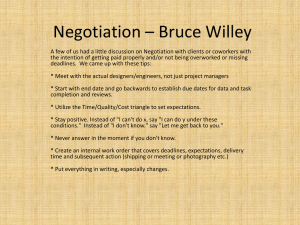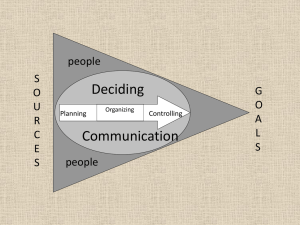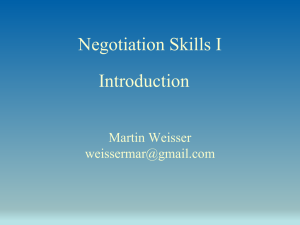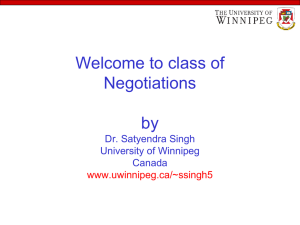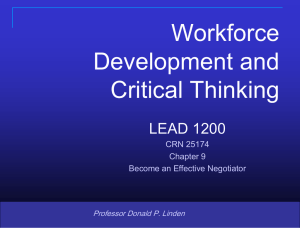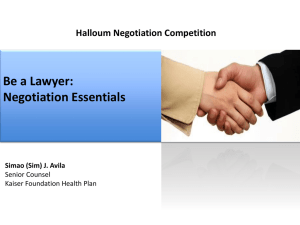Negotiation
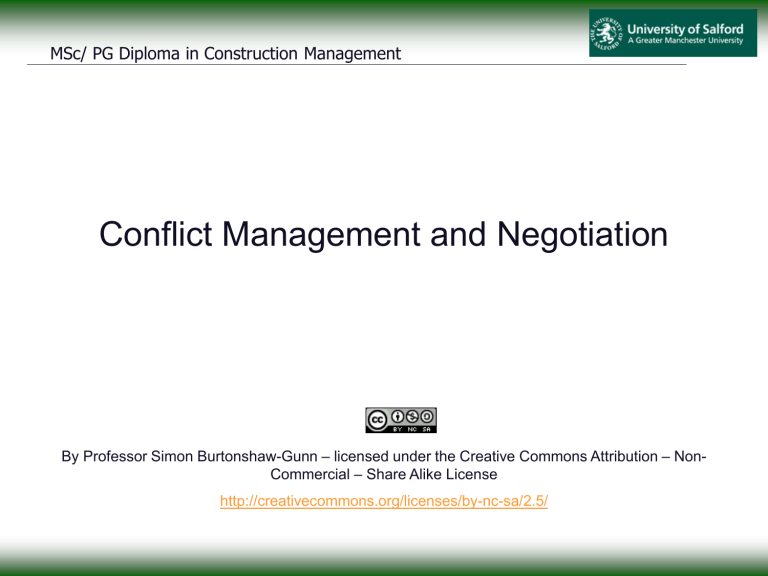
MSc/ PG Diploma in Construction Management
Conflict Management and Negotiation
By Professor Simon Burtonshaw-Gunn – licensed under the Creative Commons Attribution – Non-
Commercial – Share Alike License http://creativecommons.org/licenses/by-nc-sa/2.5/
MSc/ PG Diploma in Construction Management
School of the Built Environment
MSc Construction Management
People Management in the Built Environment
Presentation 2: Negotiation
Professor Simon Burtonshaw-Gunn
MSc/ PG Diploma in Construction Management
Presentation 2: Negotiation
• Approaches to Negotiation
•
•
•
Negotiation process
Conducting a negotiation – opening, bargaining and closing
Successful negotiation
MSc/ PG Diploma in Construction Management
Negotiation
Negotiation is a means of communicating with the aim of reaching a mutual agreement but is used for more complex communication where there is some uncertainty over the outcome.
It is simply a process whereby two parties come together to confer with a view to concluding a jointly acceptable agreement.
Such an approach can be used in conflict resolution or group decision making or problem solving.
MSc/ PG Diploma in Construction Management
Negotiation
Negotiation involves two main elements:
• Purposeful persuasion – whereby each party attempts to persuade the other to accept its case by marshalling arguments , backed by factual information and analysis.
• Constructive compromise – whereby both parties accept the need to move closer towards each other’s position, identifying the parameters of common ground within and between their positions, where there is room for concessions to be made while still meeting the needs of bath parties.
Gennard and Judge (2003)
MSc/ PG Diploma in Construction Management
Negotiation
In looking at the Negotiation process, there are two basic approaches
Distributive bargaining
Integrative bargaining
What you think that these mean?
MSc/ PG Diploma in Construction Management
Negotiation
In looking at the Negotiation process, there are two basic approaches
Distributive bargaining - negotiation about the distribution of finite resources. One party’s gain is the others loss: a win – loose or zero sum equation
Integrative bargaining – this is about joint problem solving, aiming to find a mutually satisfactory solution , win-win. The aim is not just to get the best outcome (loose-loose) but to fulfil the needs of all parties as far as possible
MSc/ PG Diploma in Construction Management
Negotiation
The Negotiation process:
•
•
•
•
Preparation - data gathering and analysis, identifying key issues, planning strategy and tactics, preparing the meeting
Opening - presentation of each side’s case
Bargaining – identifying common ground, making concessions: moving together
Closing – final offer, conclusion
MSc/ PG Diploma in Construction Management
Negotiation
Preparing a negotiations strategy:
•
•
•
•
•
Set objectives for the negotiation
Gather information
Identify potential areas of conflict
Identify potential areas of movement
Formulate a negotiating strategy – ideal outcome, realistic outcome, fall-back position, sticking points
MSc/ PG Diploma in Construction Management
Negotiation
Preparing for the Meeting:
•
•
•
•
Purpose – What is the purpose or objective of the meeting? Is it about investigation or are you intending to finalize the negotiation
Plan – where will the meeting be held? How should the room be laid out? What facilities will be required?
Pace – About 5% of any meeting time should be given to breaking the ice and making introductions, before getting down to business
Personalities – with whom are you meeting? Are they experienced negotiators?
MSc/ PG Diploma in Construction Management
Negotiation
Conducting the negotiation:
•
•
•
•
•
•
•
•
•
Opening presentation
Fact-finding
Identifying common ground
Use of negotiating strategy and bargaining power
Considering
Making concessions
The negotiating team approach
Effective communication skills
Leadership
MSc/ PG Diploma in Construction Management
Negotiation
Successful negotiation characteristics:
•
•
•
•
•
•
They avoid direct conflict
They consider a wide range of options
They hold back counter proposals rather than responding immediately
They use emollient verbal techniques: “would it be helpful if we. . . ”
They summarize on behalf of all involved
They advance single arguments insistently and avoid long winded, multiple reason arguments
(From John Hunt ‘Managing People at Work’)
MSc/ PG Diploma in Construction Management
Negotiation
Negotiation model. . .
Please see Handout of the Thomas - Kilmann Conflict Model and how this is related to the model on the next slide
MSc/ PG Diploma in Construction Management
Negotiation
Negotiation model. . .
High
Assertion
Low
Forcing: satisfying own needs at the expense of the others, usually results in hostility and resentment
Collaborating: by seeking to find and understand solutions for all parties
(a win/win strategy)
Compromising
Avoiding: potential conflict is a common approach best used when the issue or unimportant or when time is limited
Accommodating: satisfying the needs of other parties at the expense of your own needs
Low High
Co-operation
Published in Organizational Behaviour and Human Performance Volume 16 by Thomas L. Ruble and
Kenneth W. Thomas, ‘Support for a two-dimensional model of conflict behaviour’.
MSc/ PG Diploma in Construction Management
Negotiation
Closing. . .
In closing the negotiation the following items needs to be considered:
• Balance of Pros and Cons
•
•
Upside and downside costs
Cost analysis close
•
•
“Strawberry or Vanilla”
Assumptive
MSc/ PG Diploma in Construction Management
School of the Built Environment
MSc Construction Management
People Management in the Built Environment
Presentation 2: Negotiation
Professor Simon Burtonshaw-Gunn
